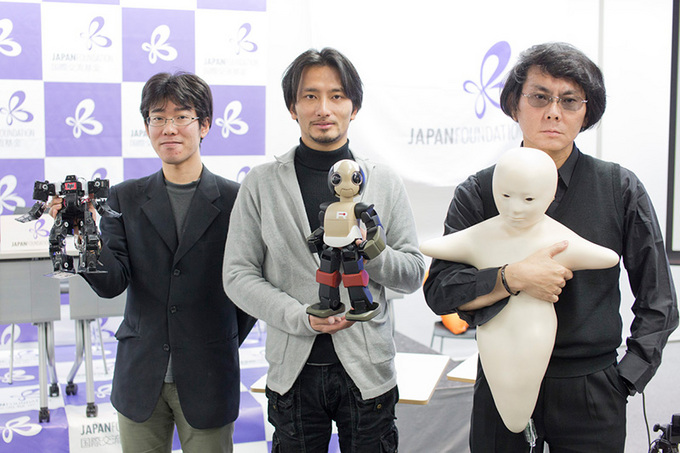Advanced Robot Nation NIPPON--At the Cutting Edge of Japanese Culture
Hiroshi Ishiguro, Tomotaka Takahashi, Wataru Yoshizaki
In the last two months of 2012, Japan's leading robotics researchers toured various parts of the world to give lectures on the theme of "Science, technology, and culture" and captivate audiences with demonstrations of their robots and technologies.
Hiroshi Ishiguro visited South Africa, Angola and Tanzania with his communication robot "Telenoid" which appears like a minimalistic human; Tomotaka Takahashi showed his small-sized humanoid robots "Evolta" and "Ropid" in Saudi Arabia, Qatar and the United Arab Emirates; and Wataru Yoshizaki introduced his easy-to-operate software "V-Sido" in Spain, Italy and Switzerland.
In Japan, robots are regarded as the ultimate fusion of cutting-edge technology and traditional Japanese culture, so we asked the three pre-eminent researchers to tell us about their impressions of how robots, in general sense, and their unique creations were received in the countries they visited, and future prospects for robotics technology.
The following is a transcript of their lecture held at the Japan Foundation JFIC Hall "Sakura" on January 10, 2013.
Robotics research as a way to learn about human beings
Hiroshi Ishiguro
Doctor of Engineering / Professor of Osaka University / Director of Intelligent Robotics and Communication Laboratories at the Advanced Telecommunications Research Institute (ATR)
As part of my association with the Japan Foundation, I have given lectures in various cities in South America, Southeast Asia, eastern Europe, and southern Africa. For me, research into robotics is linked to exploration into human beings, and so rather than merely introducing Japanese technology, I see these visits as opportunities not only to deepen my knowledge of the peoples of those nations, but also to look into future prospects for research and business activities.
This time, I visited Pretoria, Johannesburg and Cape Town in South Africa, Luanda in Angola, Dar es Salaam and Zanzibar in Tanzania, six cities in all, and talked about how the next-generation robots could help people in their everyday lives. I told my audiences, "While I'm here in Africa, my look-alike android is filling in for me back in Japan on stage." And I went on to describe the potential of android-human theaters, where the divisions between human beings and androids become increasingly blurred.
With research into androids giving me a better understanding of humans, I hit on the idea of a minimal design of human beings. That's how I came up with "Telenoid." I've talked about "Telenoid" in a number of venues around the world and it's led me to realize the effectiveness of minimal design. This time, in Africa, I had an impression that the most candid reactions came from the black students in the audience.
"Telenoid" is also very popular with older people. They seem to prefer this minimal representation of a human being, rather than a true-to-life robot that looks exactly like someone. As an example of this, in Denmark, we became the only foreign team to take part in a government-backed project to develop technology that would assist caregiving for the aged. Here in Japan, we already have "Paro," a therapeutic robot shaped like a seal that plays an active role in the care of the elderly. And with "Telenoid," we are carrying out working trials to check that the android can interact with the elderly and prevent them from feeling lonely.
These robots are effective because the human brain is designed to enable people to speak to each other. Together with the advances in robotics, we are also making progress in the areas of psychology, and the cognitive and brain sciences. By giving lectures in various parts of the world, I pass on my knowledge of the meaning of technology development and what the understanding of human beings involves, and at the same time I also benefit from the feedbacks I receive.
Worldwide venues
In the past, on trips to South America, I was gratified to see that the halls were overflowing with people wanting to hear about Japanese robots. And when I introduced robots doing very Japanese things like grappling with each other like sumo wrestlers or playing the shamisen, the audience liked it even more!
In Russia, I was always impressed by the people's interest in sharing information and keeping in touch, even after I left the country. Russia has always had the technological strength, especially with the accumulation of studies during the Cold War years. They are experts in space development. And although they aren't into miniature robots yet, they know how to produce large ones. But unlike the Western countries and Japan, they haven't yet managed to utilize that technology to good effect. So, naturally, they are very eager to learn the technology, and I have received numerous invitations from many universities and research laboratories to visit them. I also keep in touch with them frequently because I'm hoping that promising Russian students and researchers will come to study in Japan one day.
And when I visited Vietnam, I got the feeling that this was a country with great potential. Many Vietnamese people are very friendly towards Japan, and there are a lot of young people, the average age of the citizens being around the late twenties. They are very skilled with their hands, so if labor costs become too high in China, we should really think about transferring our robot-manufacturing sites to Vietnam. I think Japan should consider the country as one of its important partners in the production area, and it will also benefit from working together with Japan because this will give it a competitive edge in the international market.
And Africa, being considered as "the cradle of mankind," is a special place for me as a researcher studying humanity. My recent visit to southern Africa left me with a deep impression. Although the academic levels of the universities and research institutes are on a par with the rest of the world, social inequality is still very evident. In South Africa, with the end of apartheid, I expected there would be plenty of black students taking higher education, but in fact the universities and hi-tech research centers were dominated by white people. The towns were beautiful but they still had the reputation of being the least safe places in the world. I think Japan can do a lot to help in this area too.
New perspectives on development and business opportunities
I have been very fortunate to be able to learn so much from the places I visited. In those different venues, I have got to know the people and the countries. And it has led to our being able to welcome promising students from those countries to study here in Japan.
And let me say that developing countries have different prospects compared to the advanced nations as far as technology development is concerned. For instance, in the newly emerging economies, instead making land-line telephones readily available, they have jumped one step ahead and people get in touch with each other using mobile phones. In the same way, robotics may take a different path in their development. It would be interesting to see what contributions Japan can make here. The needs may be completely different from those in the advanced countries. I think uncovering those needs can lead to new business opportunities, and Japanese robots will soon be produced all over the world.
Japan as a global leader in robotics research
As far as robotics is concerned, Japan leads the world. In other areas, Japan has to compete fiercely with other countries such as the United States, but Japan dominates when it comes to robots and manga-animations. I believe Japan can make contributions to the developing countries in these areas, and as a result, play an important role in the world as a whole.
My visits to foreign countries have made me acutely aware of how safe and secure Japan really is. And because of that, Japan is said to be suffering from the Galapagos syndrome. In other words, it outshines other countries in many areas, but it has a backlog of numerous other issues. My trips abroad have given me an excellent opportunity to take an objective view of Japan, so I hope to be able to continue to visit new destinations.
Creating a new era of robotics
Tomotaka Takahashi
Robot creator
Among the robots I've created, perhaps the most widely known is the one that appears in the TV commercial for Panasonic: the battery-operated robot named "Evolta." It's very small, so I've been able to take it with me all around the world. Most recently, I visited Saudi Arabia, Qatar and the United Arab Emirates, and gave lectures on the theme of "Creating a new era of robotics" in five cities--Jeddah, Riyadh, Doha, Abu Dhabi, and Dubai.
Robot creation is an amalgamation of Japan's pride in the best of high technology, such as hybrid cars and digital cameras, and the pop culture world, including animation movies, manga cartoons, video games and various character creations. In other words, robots are the most powerful statement created by the two areas in which Japan excels.
My belief is that the image a Japanese person has of robots is greatly influenced by manga and animation movies, and it's quite different from that of people in other countries. The most distinctive characteristic is that Japanese people think they want to become friends with robots and imagine that robots can become a part of their daily lives. What makes me say that? Well, Japanese robots look reasonably similar to both human beings and machines at the same time. The balance is superb. On the other hand, how is a robot depicted in a Hollywood movie? It will either look 99 percent like a machine, with very little hint of human features, or it will resemble a human being so closely that the difference would be impossible to detect. Hollywood robots tend to be extreme, one way or the other, don't you think?
However, with Japanese pop culture gradually making inroads into Western society, people in the West are beginning to change their attitudes to robots and their responses are approaching those of the Japanese. So I think we are in a very fortunate position of being able to appeal the country's technology and contents together―When speaking of Japan, the first image to come to mind is robots, and when it comes to robots, Japan is the first country to spring to mind.
As a growing industry of the future
One time I participated in the RoboCup competition, I noticed that many of the teams came from the Middle East. Among them were women wearing black veils, busy soldering parts, evidence of the wide interest taken in robots in that part of the world. So it was with great expectations that I went to three countries in the Middle East on this visit.
In Qatar, I went to the 23rd Doha International Book Fair and introduced my robot at the Japan booth as part of the effort to make Japanese culture better known. A great many people, both from Qatar itself and the surrounding countries, had come to the book fair and showed a strong interest in my robot. People the world over are attracted to robots and they are very keen to see in what directions robotics as an industry will move.
In the Middle East, there is an understanding that fossil fuels will dry up in the near future and they are anxious to free their economies from a heavy reliance on oil. In other words, I could see that they were seriously looking into which areas they should be investing their capital and they were eager to find the answers. So in the midst of that situation, I was able to talk to a great many business people and also meet a number of young entrepreneurs running businesses connected to robotics.
Small, talking humanoid robot
On that lecture tour, as well as "Evolta," I took another humanoid robot called "Ropid." It can respond to the human voice with its speech recognition function, and also move around quickly, and jump and run.
Today's smartphones can respond to voice commands given by human beings, but very few people know how to use that feature to the best effect. What's the problem here? Well, people don't feel comfortable talking to an oblong box, whereas they often speak to their pet goldfish or stag beetle, even though they know those creatures don't understand them. That is because they can easily personify these pets with human characteristics.
That had led to my pursuit of miniature-sized humanoid robots development. Through conversing with a human being, a robot can absorb data on that person such as his likes and other information connected with his lifestyle, and with that data serving as its basis, it will be able to operate household appliances, order things over the Internet and have the goods delivered to the doorstep, and make life so much easier.
Look at it this way. Imagine that your smartphone has grown legs and it can slip into your breast pocket and you can talk to it, much like the eyeball character in the manga GeGeGe no Kitaro or the Tinker Bell, the fairy in Peter Pan. Instead of thinking of a robot as something that just does manual labor, I believe that in 15 years or so, we will be seeing tiny, human-shaped robots that can communicate with people. If this vision of the future can come from Japan, all the better.
Software that can even manipulate a giant robot
Wataru Yoshizaki
Technical staff member of the National Institute of Advanced Industrial Science and Technology
I am currently a doctoral student at the Nara Institute of Science and Technology, and have also set up my own company to develop robots. I have created a software system called "V-Sido" for controlling robots, from the small ones sold on the market to giant robots.
Robots available on the market can only carry out simple movements such as moving forward by operating the multi selector on the controller, and punching its hands by pressing a button. But if you use "V-Sido," you can make a robot move freely, just by using the mouse or touching the graphics on an iPhone screen. For example, you can make it do an impromptu dance, walk steadily without losing its balance. In addition, with making its posture steady on a simulator, it can faithfully copy the actions of a human being, such as bursting a balloon, movements that are sudden and explosive. You can control all these movements as though you were in the robot's cockpit, and it is also possible to operate the robot by remote control using an iPhone.
Reactions to "V-Sido" in Europe
This time, I visited three countries, Spain, Italy and Switzerland, and gave lectures in five cities--Madrid, Barcelona, Rome, Zurich, and Lausanne--in front of audiences ranging from ordinary people to engineering students and experts. I told them about the latest in robotics in Japan and what sort of influence robot animated movies had on researchers--they were of great help to me, for one. I also gave demonstrations of how "V-Sido" could be used to operate small, walking robots.
My first stop was in Madrid, where science events were being held in all over the city, and I gave my talk to students at the Carlos III University of Madrid. Students asked me questions about the scales and costs of robotics projects, and what they should be watching out for if they were planning to make such programs. I even received invitations to join them in making a giant robot.
In Rome, I gave a lecture to a general audience at the Japan Cultural Institute in Rome. When I asked how many of them had watched Japanese animated movies, almost everyone raised their hands, and about 80 percent of them said they had watched those featuring robots. So, they seemed to be more interested in what sort of robots would be fun to play with, rather than considering developing robots.
In Switzerland, at the Swiss Federal Institute of Technology Zurich (ETH Zurich), typical questions were something like, "How did you develop this technology?" or "How does the auto-balancer work?" Audiences were familiar with all the terminology and many of the questions were technical and revolved around how to reproduce the technology. There was a lively exchange of project proposals and ideas, and as a developer, this was the most rewarding demonstration from the technical point of view.
Different values in respect to robots
Since my interest in developing robots had its roots in my watching animated movies featuring robots, I always asked the same question at each of the venues: "Have you ever watched any robot movies?" As would be expected, many of them had seen the famous Gundam anime. Although there were differences among the regions and the ages of the audience members, I was amazed to learn that some people had seen Japanese anime movies that even the Japanese knew very little about.
In Japan, if you say you like robots, then you are probably talking about those robots featured in anime, or people like me who have taken their fascination with robots a little further and made them the object of their research. It struck me, however, that in the West, there is a clear difference in perception between the real and actual robots used in the manufacturing industries and the fictional ones of the anime stories.
In other words, robots in the real world gain significance only after they have carried out some useful work, whereas those in the fictional anime world are characters within a story, and people are not too concerned about the details of its mechanism.
At the moment, I am involved in developing robots that may not have an immediate role to play in society, so when people say, "There isn't much use for giant robots," I'm put into a very difficult position. The reality for the time being is that society doesn't need giant robots. But I feel that sometime in the future, through man's efforts, we may create a society where huge robots can play a useful role. So, as I go about my day-to-day research, I ask myself in what ways we could direct our efforts so that giant robots would have an invaluable part to play in society, rather than giving up the idea altogether.
(Editor: Ayako Tomokawa)
(Photos: Kenichi Aikawa)
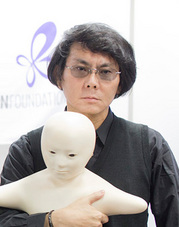 Hiroshi Ishiguro
Hiroshi Ishiguro
Researcher of intelligent robots. Among his creations is "Geminoid," an android closely resembling him. He is a professor of Osaka University and director of the Intelligent Robotics and Communication Laboratories at the Advanced Telecommunications Research Institute (ATR). He won the Osaka Culture Prize (Osaka City, Osaka Prefecture) in 2011 and the Shida Rinzaburo Award (Ministry of Internal Affairs and Communications) in 2012. He has authored numerous books including Hito to geijutsu to andoroido--watashi wa naze robotto wo tsukuru no ka (Humans, art, and androids: the reason why I create robots) (Nippon Hyoronsha).
His most recent undertaking with the Japan Foundation was a lecture demonstration tour in South Africa, Angola and Tanzania in November 2012. From January to March, 2013, he toured North America with performances given by human actors and androids, robots, a result of long years of collaboration with playwright Oriza Hirata: the works were an android-human theater called Sayonara and a robot-human theater titled I, Worker.
http://www.geminoid.jp/en/robots.html
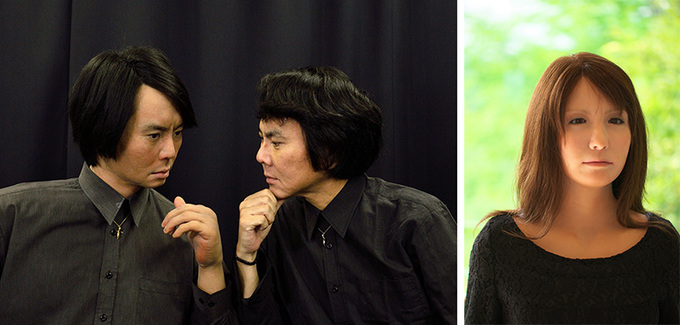
(Left) Geminoid HI-2 (Right) Geminoid F
© Hiroshi Ishiguro Laboratory, ATR
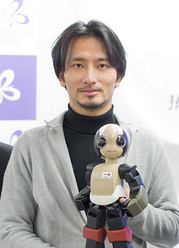 Tomotaka Takahashi
Tomotaka Takahashi
Creator of numerous friendly, sophisticated robots. Founder and CEO of Robo Garage and Project Associate Professor of The University of Tokyo. His robot "Chroino" had been selected as one of Time magazine's "Coolest Inventions 2004." In December 2012, he gave lecture demonstrations in Saudi Arabia, Qatar, and the United Arab Emirates.
http://www.robo-garage.com/en/cr/index.html
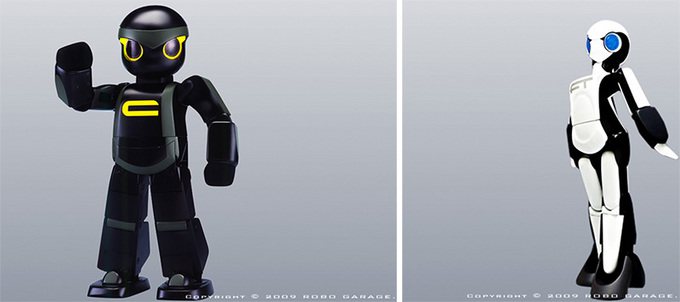
(Left) Chroino (Right) FT
© 2009 ROBO GARAGE Co., Ltd
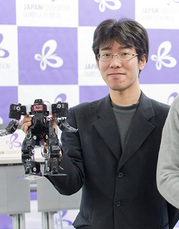 Wataru Yoshizaki
Wataru Yoshizaki
Robotics researcher and developer. He is on the technical staff of the National Institute of Advanced Industrial Science and Technology and a doctoral student at the Nara Institute of Science and Technology. In 2010, he was certified as a Super Creator at the Exploratory IT Human Resources Project of Information-technology Promotion Agency, Japan. He devised "V-Sido," a simple-to-operate control system for humanoid robots, which was equipped to run "KURATAS," a huge, 4-legged robot, for which he is also known. In November 2012, he toured Spain, Italy and Switzerland with his lecture demonstration.
http://vsido.uijin.com/en/index.html

V-Sido's functions: (Left) simple posture control (Right) AR cockpit
© Wataru Yoshizaki 2009
Back Issues
- 2025.6. 9 Creating a World Tog…
- 2024.10.25 My Life in Japan, Li…
- 2024.5.24 The 50th Japan Found…
- 2024.5.24 The 50th Japan Found…
- 2024.5. 2 People-to-People Exc…
- 2024.5. 2 People-to-People Exc…
- 2023.12. 7 Movie Theaters aroun…
- 2023.6.16 The 49th Japan Found…
- 2023.4.24 The 49th Japan Found…
- 2022.12.27 Living Together with…


